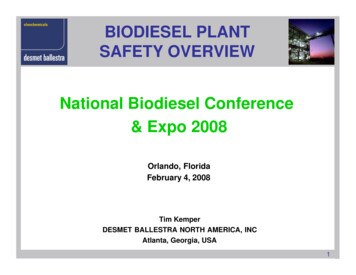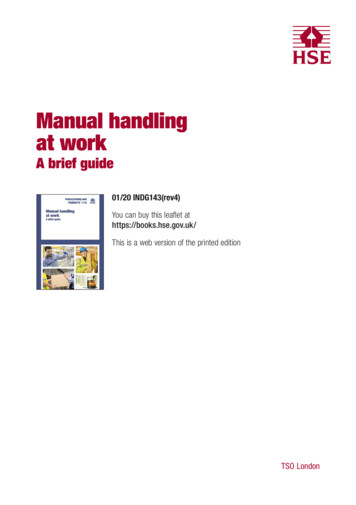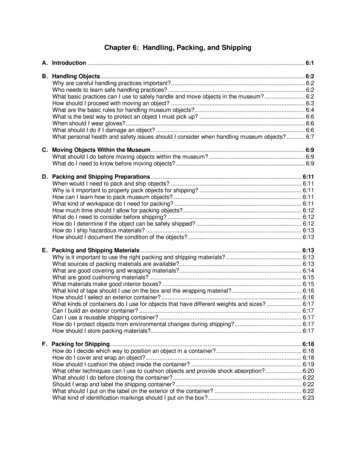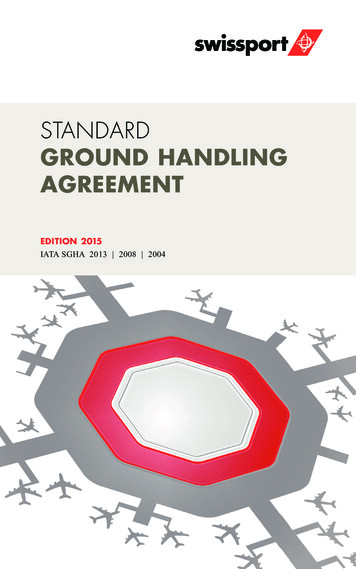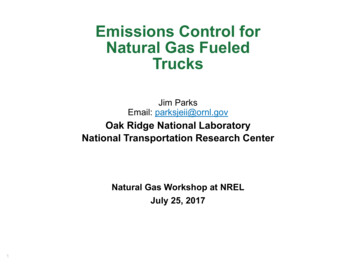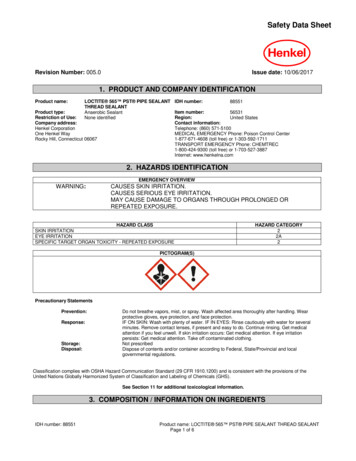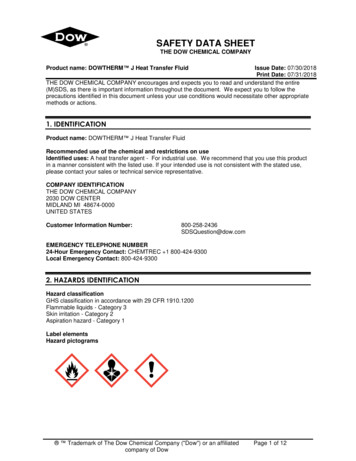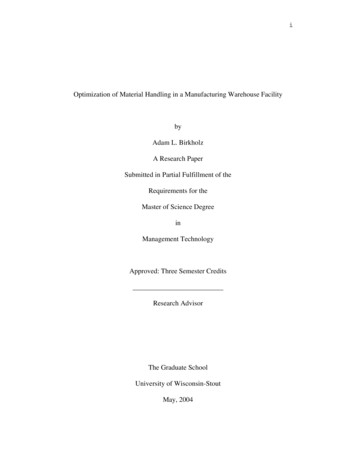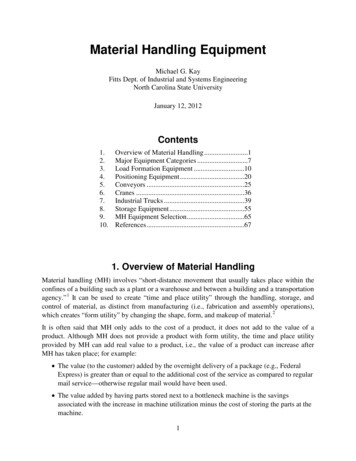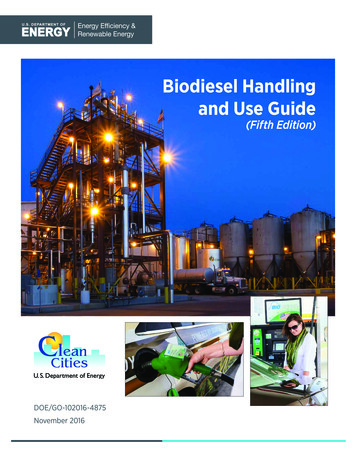
Transcription
Biodiesel Handlingand Use Guide(Fifth Edition)DOE/GO-102016-4875November 2016
DisclaimerThis report was prepared as an account of work sponsored by an agency of the UnitedStates government. Neither the United States government nor any agency thereof, nor anyof their employees, makes any warranty, express or implied, or assumes any legal liability orresponsibility for the accuracy, completeness, or usefulness of any information, apparatus,product, or process disclosed, or represents that its use would not infringe privately ownedrights. Reference herein to any specific commercial product, process, or service by tradename, trademark, manufacturer, or otherwise does not necessarily constitute or imply itsendorsement, recommendation, or favoring by the United States government or any agency thereof. The views and opinions of authors expressed herein do not necessarily state orreflect those of the United States government or any agency thereof.Every effort has been made to ensure that this manual is accurate, complete, and comprehensive at the time of publication. It is intended to be used as a guide and resource document. The authors strongly encourage all parties with an interest in establishing E85 orother ethanol blends fueling systems to engage professional support during installation toensure fuel integrity and systems compatibility.This document is not intended for use as a “how to” guide for individuals or organizationsperforming conversions.
Report Contributors and RolesLead AuthorsTeresa L. Alleman and Robert L. McCormick,National Renewable Energy LaboratoryContributing AuthorsEarl D. Christensen, Gina Fioroni, and Kristi Moriarty,National Renewable Energy LaboratoryJanet Yanowitz, EcoEngineering
ContentsIntroduction . . . . . . . . . . . . . . . . . . . . . . . . . . . . . . . . . . . . . . . . . . . . . . . . . . . . . . . . . . . . . 1Biodiesel Basics . . . . . . . . . . . . . . . . . . . . . . . . . . . . . . . . . . . . . . . . . . . . . . . . . . . . . . . . . . 3What is Biodiesel? . . . . . . . . . . . . . . . . . . . . . . . . . . . . . . . . . . . . . . . . . . . . . . . . . . . . . 3How is Biodiesel Different than Renewable Diesel? . . . . . . . . . . . . . . . . . . . . . . . . 4Benefits of Biodiesel Use . . . . . . . . . . . . . . . . . . . . . . . . . . . . . . . . . . . . . . . . . . . . . . . 5Other Biodiesel Attributes . . . . . . . . . . . . . . . . . . . . . . . . . . . . . . . . . . . . . . . . . . . . . . 6Lower Energy Density . . . . . . . . . . . . . . . . . . . . . . . . . . . . . . . . . . . . . . . . . . . . . . . 6Low-Temperature Operability . . . . . . . . . . . . . . . . . . . . . . . . . . . . . . . . . . . . . . . . 6Stability in Extended Storage . . . . . . . . . . . . . . . . . . . . . . . . . . . . . . . . . . . . . . . . 7Biodiesel (B100) . . . . . . . . . . . . . . . . . . . . . . . . . . . . . . . . . . . . . . . . . . . . . . . . . . . . . . . . . 8B100 Quality Specification . . . . . . . . . . . . . . . . . . . . . . . . . . . . . . . . . . . . . . . . . . . . . . 9Variation in Biodiesel Properties . . . . . . . . . . . . . . . . . . . . . . . . . . . . . . . . . . . . . . . . . 12Energy Content . . . . . . . . . . . . . . . . . . . . . . . . . . . . . . . . . . . . . . . . . . . . . . . . . . . . . . . 14Low-Temperature Properties . . . . . . . . . . . . . . . . . . . . . . . . . . . . . . . . . . . . . . . . . . . . 14Cetane Number . . . . . . . . . . . . . . . . . . . . . . . . . . . . . . . . . . . . . . . . . . . . . . . . . . . . . . . 15Transport and Storage . . . . . . . . . . . . . . . . . . . . . . . . . . . . . . . . . . . . . . . . . . . . . . . . . 16Stability . . . . . . . . . . . . . . . . . . . . . . . . . . . . . . . . . . . . . . . . . . . . . . . . . . . . . . . . . . . 16Microbial Contamination . . . . . . . . . . . . . . . . . . . . . . . . . . . . . . . . . . . . . . . . . . . . . 17Cleaning Effect . . . . . . . . . . . . . . . . . . . . . . . . . . . . . . . . . . . . . . . . . . . . . . . . . . . . . 18Materials Compatibility . . . . . . . . . . . . . . . . . . . . . . . . . . . . . . . . . . . . . . . . . . . . . . 18Transport . . . . . . . . . . . . . . . . . . . . . . . . . . . . . . . . . . . . . . . . . . . . . . . . . . . . . . . . . . 18Use of B100 and High Blend Levels . . . . . . . . . . . . . . . . . . . . . . . . . . . . . . . . . . . . . . 19Biodiesel Blends . . . . . . . . . . . . . . . . . . . . . . . . . . . . . . . . . . . . . . . . . . . . . . . . . . . . . . . . . 20Specifications . . . . . . . . . . . . . . . . . . . . . . . . . . . . . . . . . . . . . . . . . . . . . . . . . . . . . . . . . 20B5 and Lower Blends . . . . . . . . . . . . . . . . . . . . . . . . . . . . . . . . . . . . . . . . . . . . . . . 20B6 to B20 Blends . . . . . . . . . . . . . . . . . . . . . . . . . . . . . . . . . . . . . . . . . . . . . . . . . . . 20Pump Labeling . . . . . . . . . . . . . . . . . . . . . . . . . . . . . . . . . . . . . . . . . . . . . . . . . . . . . 20Low-Temperature Properties . . . . . . . . . . . . . . . . . . . . . . . . . . . . . . . . . . . . . . . . . . . . 22Lubricity . . . . . . . . . . . . . . . . . . . . . . . . . . . . . . . . . . . . . . . . . . . . . . . . . . . . . . . . . . . . . . 25Blending, Storage, and Transport . . . . . . . . . . . . . . . . . . . . . . . . . . . . . . . . . . . . . . . . 25Blending . . . . . . . . . . . . . . . . . . . . . . . . . . . . . . . . . . . . . . . . . . . . . . . . . . . . . . . . . . . 25Stability . . . . . . . . . . . . . . . . . . . . . . . . . . . . . . . . . . . . . . . . . . . . . . . . . . . . . . . . . . . 27Cleaning Effect . . . . . . . . . . . . . . . . . . . . . . . . . . . . . . . . . . . . . . . . . . . . . . . . . . . . . 30Materials Compatibility . . . . . . . . . . . . . . . . . . . . . . . . . . . . . . . . . . . . . . . . . . . . . . 30IV Biodiesel Handling and Use Guide (Fifth Edition) November 2016
Contents (continued)Refueling Infrastructure . . . . . . . . . . . . . . . . . . . . . . . . . . . . . . . . . . . . . . . . . . . . . . . . 31Codes and Regulations . . . . . . . . . . . . . . . . . . . . . . . . . . . . . . . . . . . . . . . . . . . . . . 31UL Listing . . . . . . . . . . . . . . . . . . . . . . . . . . . . . . . . . . . . . . . . . . . . . . . . . . . . . . . . . . 31Retail and Fleet Station Equipment . . . . . . . . . . . . . . . . . . . . . . . . . . . . . . . . . . . 32Purchasing Biodiesel . . . . . . . . . . . . . . . . . . . . . . . . . . . . . . . . . . . . . . . . . . . . . . . . . . . 35Viscosity as a Function of Temperature . . . . . . . . . . . . . . . . . . . . . . . . . . . . . . . . 35Viscosity of Various Biodiesel Blends as a Function of Temperature . . . . . . . 36BQ-9000 Program for Supply Chain Management . . . . . . . . . . . . . . . . . . . . . . . . . . . 37Engine and Vehicle Manufacturer Approvals . . . . . . . . . . . . . . . . . . . . . . . . . . . . . . . . 37Taxes and Incentives . . . . . . . . . . . . . . . . . . . . . . . . . . . . . . . . . . . . . . . . . . . . . . . . . . . . . . 38Safety, Health, and Environmental Issues . . . . . . . . . . . . . . . . . . . . . . . . . . . . . . . . . . . 39Signs, Labels, and Stickers . . . . . . . . . . . . . . . . . . . . . . . . . . . . . . . . . . . . . . . . . . . . . . 39Fire Safety Considerations . . . . . . . . . . . . . . . . . . . . . . . . . . . . . . . . . . . . . . . . . . . . . . 39Checklist for Installing B20 Dispensing Equipment orConverting Underground Storage Tanks . . . . . . . . . . . . . . . . . . . . . . . . . . . . . . . . . 40Frequently Asked Questions . . . . . . . . . . . . . . . . . . . . . . . . . . . . . . . . . . . . . . . . . . . . . . 41Information Resources . . . . . . . . . . . . . . . . . . . . . . . . . . . . . . . . . . . . . . . . . . . . . . . . . . . . 42Glossary . . . . . . . . . . . . . . . . . . . . . . . . . . . . . . . . . . . . . . . . . . . . . . . . . . . . . . . . . . . . . . . . . 43Appendix A. Sample Biodiesel Safety Data Sheet . . . . . . . . . . . . . . . . . . . . . . . . . . . . 45Appendix B. Biodiesel Use as an EPAct Alternative Fuel . . . . . . . . . . . . . . . . . . . . . . 53Appendix C. Biodiesel Materials Compatibility Summary Tables . . . . . . . . . . . . . . 54Elastomers . . . . . . . . . . . . . . . . . . . . . . . . . . . . . . . . . . . . . . . . . . . . . . . . . . . . . . . . . . . . 54Metals . . . . . . . . . . . . . . . . . . . . . . . . . . . . . . . . . . . . . . . . . . . . . . . . . . . . . . . . . . . . . . . . 55UL Standards . . . . . . . . . . . . . . . . . . . . . . . . . . . . . . . . . . . . . . . . . . . . . . . . . . . . . . . . . 56Tank Manufacturer Compatibility . . . . . . . . . . . . . . . . . . . . . . . . . . . . . . . . . . . . . . . . 57Underground Equipment . . . . . . . . . . . . . . . . . . . . . . . . . . . . . . . . . . . . . . . . . . . . . . . 58Aboveground Equipment (Dispensers, Hanging Hardware, etc.) . . . . . . . . . . . . . 62Appendix D. BQ-9000 Sample Certificate of Analysis . . . . . . . . . . . . . . . . . . . . . . . . 63November 2016 Biodiesel Handling and Use Guide (Fifth Edition) V
FiguresFigure 1. Basic transesterification process . . . . . . . . . . . . . . . . . . . . . . . . . . . . . . . . . . . . . . . . . . . . . . . . . . . . . . . . . . . . . 3Figure 2. Composition of various biodiesel feedstocks in order of increasing saturated fatty acid content . . . . . . . . 13Figure 3. Cetane numbers of two petroleum diesels and several biodiesels. . . . . . . . . . . . . . . . . . . . . . . . . . . . . . . . . . 15Figure 4. ASTM D4625 long-term storage stability for B100 samples having a range of initial induction periods . . 17Figure 5. FTC-compliant B20 and B100 pump labels. . . . . . . . . . . . . . . . . . . . . . . . . . . . . . . . . . . . . . . . . . . . . . . . . . . 20Figure 6. Biodiesel/diesel blend cloud point test results . . . . . . . . . . . . . . . . . . . . . . . . . . . . . . . . . . . . . . . . . . . . . . . . . 22Figure 7. Biodiesel/diesel blend pour point test results. . . . . . . . . . . . . . . . . . . . . . . . . . . . . . . . . . . . . . . . . . . . . . . . . . 22Figure 8. Adjusting cloud points of B20 fuels with blends of No. 1 and No. 2 diesel. . . . . . . . . . . . . . . . . . . . . . . . . . . 23Figure 9. Cold flow properties of some soy biodiesel blends, C. . . . . . . . . . . . . . . . . . . . . . . . . . . . . . . . . . . . . . . . . . . 24Figure 10. HFRR lubricity as a function of biodiesel content for a No. 1 and a No. 2 diesel fuel . . . . . . . . . . . . . . . . 25Figure 11. D4625 storage results for B5 blends made from B100 with varying levels of oxidation stabilityand two diesel fuels as measured by EN15751. . . . . . . . . . . . . . . . . . . . . . . . . . . . . . . . . . . . . . . . . . . . . . . . . 28Figure 12. D4625 storage results for B20 blends made from B100 with varying levels of oxidation stabilityas measured by EN15751 . . . . . . . . . . . . . . . . . . . . . . . . . . . . . . . . . . . . . . . . . . . . . . . . . . . . . . . . . . . . . . . . . 29Figure 13. Typical fuel dispenser and underground storage piping. . . . . . . . . . . . . . . . . . . . . . . . . . . . . . . . . . . . . . . . . 33Figure 14. Dispenser and hanging hardware. . . . . . . . . . . . . . . . . . . . . . . . . . . . . . . . . . . . . . . . . . . . . . . . . . . . . . . . . . 34Figure 15. Kinematic viscosity of three biodiesels. . . . . . . . . . . . . . . . . . . . . . . . . . . . . . . . . . . . . . . . . . . . . . . . . . . . . . 35Figure 16. Kinematic viscosity for a commercial biodiesel in various blends . . . . . . . . . . . . . . . . . . . . . . . . . . . . . . . . 36Figure 17. Placards for transport of combustible and flammable liquids. . . . . . . . . . . . . . . . . . . . . . . . . . . . . . . . . . . . 39TablesTable 1. Biodiesel Blend Levels Requiring NOx-reducing Additives. . . . . . . . . . . . . . . . . . . . . . . . . . . . . . . . . . . . . . . . . 5Table 2. Select Properties of Typical No. 2 Diesel and Biodiesel Fuels . . . . . . . . . . . . . . . . . . . . . . . . . . . . . . . . . . . . . . 8Table 3. Requirements for Biodiesel (B100) Blend Stock as Listed in ASTM D6751-15cε1. . . . . . . . . . . . . . . . . . . . . . . 9Table 4. Cold Flow Data for Various B100s. . . . . . . . . . . . . . . . . . . . . . . . . . . . . . . . . . . . . . . . . . . . . . . . . . . . . . . . . . . 15Table 5. ASTM D7467-15cε1 Specification for Diesel Blends B6 to B20. . . . . . . . . . . . . . . . . . . . . . . . . . . . . . . . . . . . . 21Table 6. Fuel Dispenser and Underground Storage Piping Components. . . . . . . . . . . . . . . . . . . . . . . . . . . . . . . . . . . . 33Table 7. Constants for Best Fit Regression Equation . . . . . . . . . . . . . . . . . . . . . . . . . . . . . . . . . . . . . . . . . . . . . . . . . . . 35Table C-1. Elastomer Compatibility with Biodiesel. . . . . . . . . . . . . . . . . . . . . . . . . . . . . . . . . . . . . . . . . . . . . . . . . . . . . 53Table C-2. UL Biodiesel Testing Standards for Refueling Equipment. . . . . . . . . . . . . . . . . . . . . . . . . . . . . . . . . . . . . . 55Table C-3. Tank Manufacturer Compatibility with Biodiesel Blends. . . . . . . . . . . . . . . . . . . . . . . . . . . . . . . . . . . . . . . 56Table C-4. Underground Equipment . . . . . . . . . . . . . . . . . . . . . . . . . . . . . . . . . . . . . . . . . . . . . . . . . . . . . . . . . . . . . . . . 57Table C-5. Dispensers, Hanging Hardware, Shear Valves, Submersible Turbine Pumps . . . . . . . . . . . . . . . . . . . . . . . 61VI Biodiesel Handling and Use Guide (Fifth Edition) November 2016
Abbreviations and Acronyms C degrees Celsiusmg milligram F degrees Fahrenheitmg KOH/g milligrams of potassium hydroxideper gramAFV alternative fuel vehiclemm2/s square millimeter per secondAST aboveground storage tankNa sodiumASTM ASTM InternationalNBB National Biodiesel BoardB100 100% biodieselBXX XX% biodiesel,(100 – XX)% petroleum dieselNOx nitrogen oxidesNREL National Renewable Energy LaboratoryBtu British thermal unitNTDE new technology diesel engineCa calciumOEM original equipment manufacturerCARB California Air Resources BoardOSHA Occupational Safety and HealthAdministrationCFPP cold filter plugging pointPM particulate matterCO2 carbon dioxideEPA U.S. Environmental Protection AgencyRDxx XX% renewable diesel,(100 – XX)% petroleum dieselEPAct Energy Policy Act of 1992(amended in 1998)RFS Renewable Fuels StandardFAME fatty acid methyl estersSDS safety data sheetg gramHFRR high-frequency reciprocating rigK potassiumkg kilogramLTFT low-temperature flow testmass % percent by massMg magnesiumppm parts per millionSMG saturated monoglyceridesUL UL LLC (formerly UnderwritersLaboratories)UST underground storage tankvol % percent by volumeWayne Wayne Fueling Systems LLCwt % percent by weightNovember 2016 Biodiesel Handling and Use Guide (Fifth Edition) VII
VIII Biodiesel Handling and Use Guide (Fifth Edition) November 2016
IntroductionThis document is a guide for those who blend, distribute, and use biodiesel and biodiesel blends. It providesbasic information on the proper and safe use of biodiesel and biodiesel blends in engines and boilers, andis intended to help fleets, individual users, blenders,distributors, and those involved in related activitiesunderstand procedures for handling and usingbiodiesel fuels.Biodiesel is manufactured from plant oils, animal fats,and recycled cooking oils and has several advantages.Biodiesel: Is renewable Displaces petroleum-derived diesel fuel Can be used in most diesel equipment withno or only minor modifications Can reduce global warming greenhouse gasemissions Is compatible with new technology diesel engines(NTDE) and emissions control devices Can reduce tailpipe emissions from oldervehicles, including air toxics Is nontoxic, biodegradable, and suitable forsensitive environments Is produced domestically from agricultural orrecycled resources.In this report, biodiesel refers to the fuel producedfrom renewable sources that meets ASTM International(ASTM) Standard D6751-15cε1 (the latest standard forbiodiesel used as a blendstock). A number following theletter “B” indicates the percent by volume (vol%) of biodiesel in a gallon of fuel; the remainder of the gallon canbe No. 1 or No. 2 diesel, kerosene, Jet A, JP8, heatingoil, or any other distillate fuel. Pure (or neat) biodiesel isalso known as B100.Biodiesel is most commonly used as a blend with petroleum diesel. At concentrations of up to 5 vol% (B5) inconventional diesel fuel, the mixture will meet ASTMD975 diesel fuel specification and can be used in anyapplication as if it were neat petroleum diesel; for homeASTM International (astm.org) is a consensusbased volunteer standards group that comprisesexperts across numerous industries. Committee D02, Petroleum Products, Liquid Fuels, andLubricants, covers biodiesel, diesel, and heatingoil specifications (in addition to many other products). Membership in D02 includes engine andfuel injection equipment companies, fuel producers, and fuel users. ASTM standards are recognized in the United States by most governmententities. Specifications are living documents andmay be updated frequently to reflect the mostcurrent needs of the industry. Any ASTM methodor specification will include a number and a year,such as D6751-15cε1. This means the most currentversion of the method was published in 2015;a letter after the year indicates that more thanone modification has been published in a givenyear. It is up to users to ensure they are usingthe most up-to-date version of a test methodor specification.heating oil, B5 will meet the ASTM D396 home heatingoil specification.1 At concentrations of 6% to 20% (B6 toB20), biodiesel blends can be used in many applicationsthat use diesel fuel with minor or no modifications to theequipment, although not all engine manufacturers haveapproved these blends for use in their equipment. B6 toB20 blends are covered by ASTM Specification D746715cε1. Biodiesel can even be used as a fuel in its neatform (B100) if proper precautions are taken. AppendixA shows a sample Safety Data Sheet for biodiesel.Commonly used blends are limited to B20 in the UnitedStates because this level provides a good balancebetween material compatibility, cold weather operability, performance, and emission benefits, as studied.B20 is also the minimum blend level allowed for compliance with the Energy Policy Act of 1992 (EPAct), whichrequires the use of renewable fuels and/or alternativefuel vehicles (AFVs) by certain covered fleets. Equip-1. The ASTM standard for B100 to be used as a blend stock is D6751. Diesel fuel is defined in ASTM D975. ASTM D396 defines heating oils.A-A-59693A defines B20 for military use.November 2016 Biodiesel Handling and Use Guide (Fifth Edition) 1
ment that can use B20 includes diesel engines, fuel oiland heating oil boilers, and turbines.Higher blend levels such as B50, and B100 requirespecial handling and may require equipment modifications. These issues can potentially be managed withheaters and/or changing engine seal and gasket materials. Consult your engine or combustion equipmentmanufacturer for further information about proceduresbefore using biodiesel blends higher than B20.2 Biodiesel Handling and Use Guide (Fifth Edition) November 2016
Biodiesel BasicsThis section provides a basic overview of biodiesel. Youcan also refer to Section 9 (Frequently Asked Questions)for answers to general questions from your management,customers, or reporters. Technical details about manyaspects of biodiesel are provided in Sections 3 to 8.What is Biodiesel?Biodiesel is a diesel replacement fuel for use in dieselengines. It is manufactured from plant oils (e.g.,soybean oil, cottonseed oil, canola oil, corn oil);recycled cooking greases or oils (e.g., yellow grease); oranimal fats (beef tallow, pork lard); and various combinations of these feedstocks. Used cooking oils aremostly plant based, but may also contain animal fats.Used cooking oils are both recycled and renewable.As biodiesel production and use increase, new feedstocks are being developed and may soon be introducedinto the market. Some examples include pennycress,camelina, cuphea, brown grease, and various strainsof algae. Although there is little biodiesel from thesefeedstocks currently available, there is great potentialfor these feedstocks to supplement the currentfeedstock supply.The biodiesel manufacturing process converts oils andfats into chemicals called long-chain mono alkyl esters,or biodiesel. These chemicals are also referred to asfatty acid methyl esters (FAME), and the process isreferred to as esterification. Figure 1 provides a simplified diagram of the esterification process. Roughlyspeaking, 100 pounds of oil or fat are reacted with 10pounds of a short-chain alcohol (usually methanol) inthe presence of a catalyst (usually sodium hydroxide orpotassium hydroxide) to form 100 pounds of biodieseland 10 pounds of glycerin (or glycerol). Glycerin is asugar and is a co-product of the biodiesel process.Biodiesel is a legally registered fuel and fuel additivewith the U.S. Environmental Protection Agency (EPA).The EPA registration is feedstock and process agnosticand includes all biodiesel that meets the ASTM biodiesel specification, ASTM D6751.2Straight Vegetable Oil and Other ProductsRaw or refined plant oils, fats, or recycled greases thathave not been processed into biodiesel, such as straightvegetable oil (SVO), are not biodiesel and should beavoided. Research shows that plant oils, animal fats,and/or greases used in diesel engines, even at concentrations as low as 1%, can cause long-term engine deposits,ring sticking, lube oil gelling and other maintenanceproblems, and can reduce engine life. These problemsare caused mostly by the much higher viscosity, orthickness, of the raw fats and/or oils (around 40 squaremillimeters per second [mm2/s]) compared to that ofdiesel fuel, for which the engines and injectors weredesigned (1.3 to 4.1 mm2/s). The significantly higherboiling point of raw fats and oils may also lead to failureof the fuel to fully evaporate, especially during coldstart, leading to harmful engine deposits and engine oilsludging. Through the process of converting plant oilsor greases to biodiesel by esterification, the viscosityand boiling point of the fuel are reduced to values moresimilar to conventional diesel fuel (biodiesel viscosityvalues are typically 4 to 5 mm2/s).2. astm.org.Vegetable Oil/Animal Fat/WasteMethanolplus selCrude GlycerinFigure 1.Basic Esterification vember 2016 Biodiesel Handling and Use Guide (Fifth Edition) 3
Other products, many of which are offered to consumers without the benefit of EPA registration, ASTM specifications, or extensive testing and demonstrations, maybe mislabeled as “biofuels,” “renewable diesel,” or evenas “biodiesel.” It is up to the consumer to be aware ofwhat they are purchasing. If you purchase methyl estersthat do not meet ASTM biodiesel standards, it is notlegal biodiesel and should not be used in diesel enginesor other equipment designed to operate on diesel fuel.Methyl esters are used as an industrial lubricant andsolvent in some applications, so be sure to purchaseonly ASTM D6751-grade methyl esters (biodiesel) foruse in diesel engines.Specifications and RegulationsSpecification D6751 is based on a compilation of effortsfrom researchers, engine manufacturers, petroleumcompanies and distributors, and many other fuelrelated entities and is intended to ensure the quality ofbiodiesel used as a blendstock at 20% (B20) and lowerblend levels. Any biodiesel used in the United Statesfor blending should meet ASTM D6751 standards. TheASTM standards provide a minimum level of quality forbiodiesel regardless of the source of the fuel. Purchasersand sellers can require that biodiesel meet more stringent requirements in purchasing specifications. Bothparties must agree to these more stringent requirements,and this is becoming an increasingly common practice.The ASTM D6751 definition of biodiesel states that biodiesel is composed of “mono-alkyl esters of long-chainfatty acids derived from plant oils or animal fats.” Theterm mono-alkyl esters indicates that biodiesel containsonly one ester linkage in each molecule. Raw or refinedplant oils, animal fats, and greases contain three esterlinkages and are therefore not legally biodiesel. Biodiesel can be made from methyl, ethyl, isopropyl, andother alcohols. Virtually all commercial biodiesel production in the United States today is based on methylesters. Some research has been conducted on ethylesters (biodiesel produced with ethanol as the alcoholrather than methanol); however, higher ethanol pricesrelative to methanol, lower ethyl ester conversions,and the difficulty of recycling excess ethanol from thefinished biodiesel have hampered ethyl ester productionin the marketplace. Therefore, in this document we willconsider only methyl esters.The definition of biodiesel recognized by both the EPAfor fuel registration purposes and the Internal RevenueService for the blender’s tax credit is essentially thesame as the definition in ASTM D6751:“A fuel comprised of mono-alkyl esters of long-chainfatty acids derived from vegetable oils or animal fats,designated B100, and meeting the requirements ofASTM D6751.”EPAct requires that certain federal, state, and alternative fuel provider fleets acquire a fixed percentage (75%or 90%) of AFVs each year based on the total numberof light-duty vehicles they acquire. A light-duty vehiclethat is approved by the original equipment manufacturer (OEM) to operate on B100 or a biodiesel blendof B20 or higher qualifies as an AFV under EPAct. Asof 2015, there are no light-duty vehicles on the marketapproved to operate on B100, but there are many thatare approved to operate on B20. Neat biodiesel may bemore expensive than other alternative fuel options, andOEMs have shown little interest in obtaining approvalfor on-road vehicles to operate on B100.Congress amended EPAct through the Energy Conservation Reauthorization Act of 1998. Among otherthings, the Energy Conservation Reauthorization Actadded Section 312 to EPAct, thereby enabling coveredfederal, state, and alternative fuel provider fleets to earnAFV credits for their use of B20 or higher blends inmedium- or heavy-duty vehicles (those vehicles with agross vehicle weight rating of more than 8,500 pounds),with some limitations. This provision has createdsignificant demand for B20 among government andalternative fuel provider fleets (Appendix B).How is Biodiesel Different thanRenewable Diesel?Renewable diesel is a hydrocarbon diesel fuelproduced from renewable feedstocks. Today, allrenewable diesel on the market is, like biodiesel, produced from fats and oils. The way these fats and oilsare reacted into fuels is the defining difference betweenbiodiesel and renewable diesel. As discussed above,biodiesel is primarily made through esterification.Renewable diesel is produced by hydroprocessing of fatsand oils. Hydroprocessing produces alkanes, which arechemically identical to some of the compounds foundin conventional diesel fuel. The properties of renewablediesel are also different from biodiesel. Like biodiesel,renewable diesel has near-zero aromatic content andvery low sulfur content. It typically has a very highcetane number and a cloud point more like conventionaldiesel fuels. When used as a neat fuel (RD100), RD100qualifies as an EPAct alternative fuel, while lowerblends, such as RD20, do not.4 Biodiesel Handling and Use Guide (Fifth Edition) November 2016
The only way to determine if diesel fuel has beenblended with renewable diesel fuel is through carbondating using ASTM D6866. In this method, the isotopic ratio of fossil to biological carbon is quantified.Petroleum diesel will be wholly fossil carbon, while therenewable diesel (or biodiesel) content will be identifiedas biogenic carbon.Benefits of Biodiesel UseBiodiesel Reduces Greenhouse Gas EmissionsWhen biodiesel displaces petroleum, it significantlyreduces life-cycle greenhouse gas emissions. Life cycleanalysis completed by Argonne National Laboratoryfound that greenhouse gas emissions for B100 are 74%lower than those from petroleum diesel. More recently,the California Air Resources Board (CARB) reportedsimilar values for its life-cycle analysis of biodiesel fromvarious sources.3When oilseed plants grow, they take carbon dioxide(CO2) from the air to make the stems, roots, leaves, andseeds. After the oil is extracted from the oilseeds, it isconverted into biodiesel. When the biodiesel is burned,CO2 and other emissions are released and returned tothe atmosphere. On balance, most of this emitted CO2does not add to the net CO2 concentration in the airbecause the next oilseed crop will reuse the CO2 as itgrows. A small fraction of the emitted carbon is fossilderived because of fossil fuel and chemicals used infarming and in the biodiesel production process.Biodiesel Reduces Tailpipe EmissionsTesting to date shows that biodiesel is fully co
November 2016 Biodiesel Handling and Use Guide (Fifth Edition) 3 This section provides a basic overview of biodiesel. You can also refer to Section 9 (Frequently Asked Questions) for answers to general questions from your management, customers, or reporters. Technical details about many aspects of
